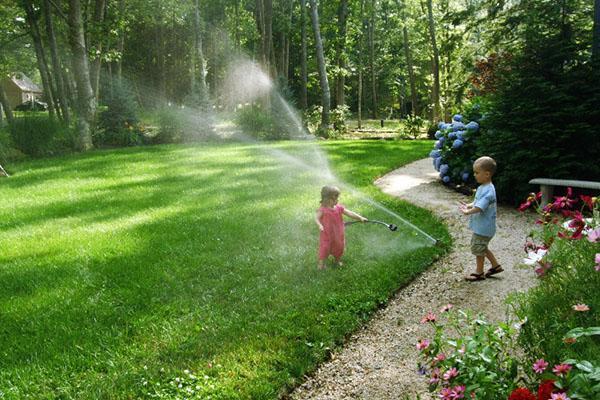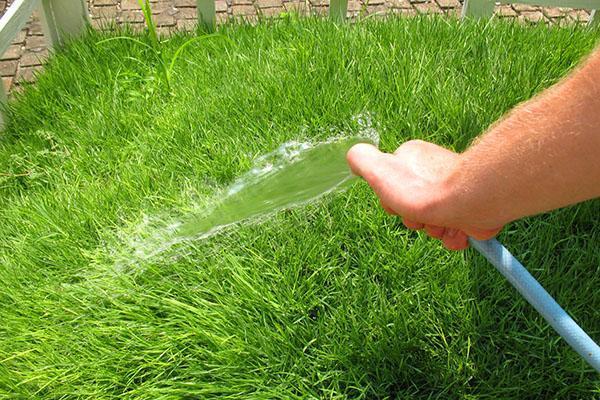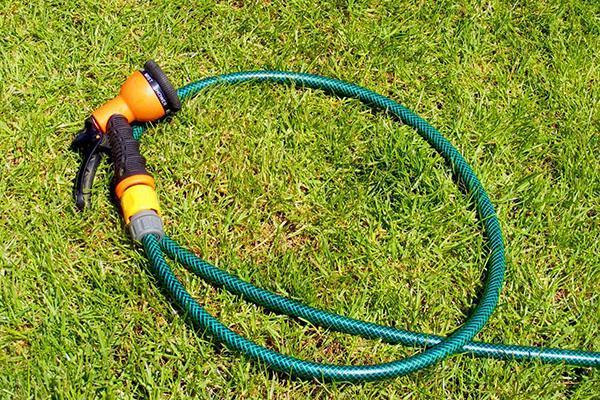Features of the design and installation of the lawn irrigation system
 In order for the green lawn to retain its freshness in any weather, the grass grows evenly and amicably, the site owner needs a specialized lawn watering system.
In order for the green lawn to retain its freshness in any weather, the grass grows evenly and amicably, the site owner needs a specialized lawn watering system.
You cannot do without it for several reasons:
- The area is too large to manually wet the soil. It is too laborious, and you cannot guarantee that such watering will be uniform.
- Using a garden hose will speed up irrigation, but a powerful jet of water will inevitably damage the root system of the grass, wash out the soil and compromise the integrity of the canopy. Yes, and once again walk on the emerald carpet is not worth it.

Types of irrigation systems for lawns
Existing irrigation systems for the lawn are divided into those that work in manual and semi-automatic modes, but the most perfect are fully automated designs.
 The main advantage of the manual lawn watering system is the low cost of all components. And the disadvantage is the indispensable participation of a person who:
The main advantage of the manual lawn watering system is the low cost of all components. And the disadvantage is the indispensable participation of a person who:
- decides on the need to supply moisture from shutdown;
- monitors the degree of soil moisture;
- connects and transfers hoses and all kinds of lawn sprinklers.
In fact, such a system can represent the simplest circuit of pipes with hydrants removed. Hoses and other lawn irrigation equipment are connected to them, which helps to cut the water jet and ensure maximum coverage of the area.
The arrangement of the irrigation system is carried out in such a way that the pipeline does not suffer from frost in winter. Therefore, the depth of the pipes in different regions may vary.
Systems operating in semi-automatic mode only need to be turned on and off in time.  The programmable lawn sprinklers are responsible for the quality of spraying and coverage of the territory.
The programmable lawn sprinklers are responsible for the quality of spraying and coverage of the territory.
Automatic watering of the lawn removes from the owner of the site almost all worries about this stage of lawn care. It is the most expensive and troublesome to set up, but at the same time it saves maximum time, water and is very durable.
Automatic lawn watering
Systems automatic watering include several types of equipment:
- underground pipeline;
- pump or pumping station of proper performance;
- sensors that measure soil moisture and determine the need to turn on irrigation;
- storage tank for backup storage and heating of moisture;
- solenoid valves;
- hydrants;
- complex of automation;
- lawn sprinklers.
 The underground part of the lawn irrigation equipment, pumping systems and automation are calculated taking into account the productivity of the moisture source, as well as the need for it. Sprinklers are selected depending on the configuration of the site, the crops planted on it and the location of other objects.
The underground part of the lawn irrigation equipment, pumping systems and automation are calculated taking into account the productivity of the moisture source, as well as the need for it. Sprinklers are selected depending on the configuration of the site, the crops planted on it and the location of other objects.
Lawn sprinklers can be of different design, which determines the area and method of irrigation. Such devices can be of two types:
- rotary structures with the possibility of circular rotation of the head irrigate the soil within a radius of 11–20 m;
- the fan-shaped lawn sprinklers cannot rotate, and the coverage of an area up to 5 m is carried out thanks to the different shapes of the nozzles.
Design of irrigation systems for lawns
 The basis for starting the design of a lawn irrigation system is:
The basis for starting the design of a lawn irrigation system is:
- site plan showing all buildings, fences, paths, large and small garden crops that require attention;
- plan with marked location of the source of irrigation moisture;
- well productivity and water quality data.
The last point is extremely important if autonomous water supply is used. For example, moisture from natural water bodies, drainage systems and storm sewers can contain an increased number of microorganisms that negatively affect the soil and plants. Therefore, it is not recommended to use such water for irrigation without preliminary treatment and disinfection.
The design of the irrigation system and the installation of equipment for watering the lawn is carried out in such a way that the plants do not suffer from a lack of moisture, but are not in an excessively moist substrate.
The watering rate is determined taking into account:
- the type of soil on the site;
- the frequency of precipitation in the warm season;
- temperature regime;
- the needs of the crops available.
 It is important to remember that watering is for green spaces and not for paths, home, or garden benches. This aspect is taken into account when determining the location, power and design of the lawn sprinklers.
It is important to remember that watering is for green spaces and not for paths, home, or garden benches. This aspect is taken into account when determining the location, power and design of the lawn sprinklers.
Features of installation of equipment for watering the lawn
If the lawn has a simple shape, and it is not intended to plant any other ornamental crops, the installation of equipment for watering the lawn can be carried out before sowing the grass.
When lawn grass is planted between shrubs, garden trees or flower beds are laid out on the lawn, these circumstances must be taken into account when designing and installing an irrigation system.
In such a situation, it is better to start laying pipes, installing automation and other components of the irrigation system with large crops planted in a plot that is completely prepared for sowing.
How is a lawn irrigation system installed? Follow the directions:
- According to the planned plan, the marking of the places where the pipes will be laid, hydrants, switchgears and sprinklers are installed.
- Then trenches are laid so that the pipes are below the depth of soil freezing in the region, and the slope necessary to maintain the pressure is provided.
- The pipeline and all the necessary equipment for the automation of irrigation are being laid.
- After the system has been tested, the trenches are buried and the lawn sprinklers are installed.
If the grass cover is damaged during the laying of the irrigation system, the damaged areas are cut out, and turf of the same shape is laid out in their place. For these purposes, you can use a roll lawn. After repair, the coating must be watered.